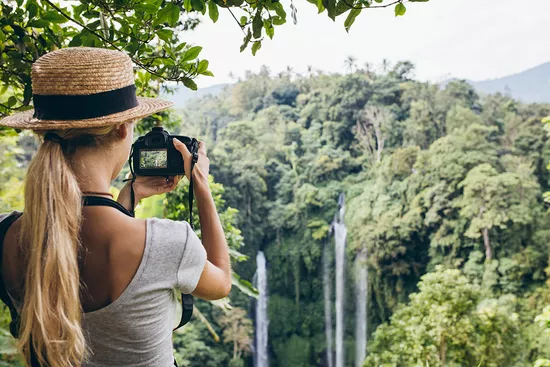Reisen und Pflanzen
Sie reisen gerne? Passen Sie bei Pflanzen auf.
Pflanzenkrankheiten und -schädlinge reisen gerne mit. Und sie breiten sich schnell aus.
Im Oktober 2013 wurde Xylella fastidiosa erstmals in Italien nachgewiesen. Aller Wahrscheinlichkeit nach wurde das pflanzenpathogene Bakterium aus Nord-, Mittel- oder Südamerika – dort ist es in vielen Regionen weit verbreitet – in die EU eingeschleppt.
Das Ergebnis? Eine verheerende Krise für Umwelt und Wirtschaft.
In der italienischen Region Apulien vernichtete das Bakterium ein Drittel der ehemals 60 Millionen Olivenbäume und verursachte Schäden in Höhe von über einer Milliarde Euro. Inzwischen hat es sich auch in Frankreich, Spanien und Portugal verbreitet.
Wie können wir verhindern, dass so etwas noch einmal passiert?
Indem wir strenger kontrollieren, was in die EU und in die Schweiz gelangt – nicht nur an den Grenzen und in den Häfen, sondern auch in unserem Reisegepäck.

Bewundern und stehen lassen
Wussten Sie, dass alle Pflanzen und Pflanzenerzeugnisse – sogar Schnittblumen – ein Pflanzengesundheitszeugnis benötigen, um legal in die EU und die Schweiz eingeführt werden zu können?
Pflanzengesundheitszeugnisse werden in Ländern ausserhalb der Schweiz und der EU von den dortigen Pflanzenschutzbehörden ausgestellt. Sie sind für den Handel mit Pflanzen und Pflanzenerzeugnissen erforderlich und bescheinigen, dass die Ware frei von Schädlingen ist und ausgeführt werden darf.
(In der EU angekommen, muss die Ware erneut geprüft werden und erhält dann einen Pflanzenpass, mit dem sie innerhalb der Schweiz und der Europäischen Union verbracht werden darf.)
Auf Auslandsreisen ist die Versuchung gross, ein pflanzliches Souvenir mitzubringen, etwa einen hübschen Setzling von der Dschungelsafari, einen Zweig von einer Wanderung oder einen handgebundenen Kranz vom Dorfmarkt.
Sie mögen harmlos erscheinen und vielleicht sogar unbemerkt den Zoll passieren. Doch ohne die korrekte Genehmigung könnten sie gefährliche Schädlinge einschleppen, die europäische Ökosysteme zerstören.
Darum gilt: Wenn Sie ausserhalb der Schweiz und der EU oder in überseeischen Gebiete[1] der EU reisen, lassen Sie Pflanzen und Pflanzenerzeugnisse dort – damit unsere heimischen Arten geschützt werden und unsere Ökosysteme weiter gedeihen.

Haben Sie Waren anzumelden? Schauen wir mal ...
Frisches Obst im Handgepäck mag gesünder scheinen als die Snacks an Bord, doch es könnte Krankheitserreger oder Schädlinge in sich tragen.
Werfen Sie deshalb einen Blick in Ihr Hand- und Aufgabegepäck, bevor Sie Ihren Rückflug antreten: Haben sich Pflanzenbestandteile wie Blätter, Zweige oder Wurzeln darin versteckt, oder haben Sie pflanzliche Mitbringsel dabei?
So vermeiden Sie nicht nur die Beschlagnahmung beim Zoll, sondern helfen auch mit, unsere Gärten, Wälder und Nutzpflanzen zu schützen.
Werden Sie Reise-Influencer für Pflanzengesundheit
Soziale Medien haben grosse Wirkung – sie prägen Gewohnheiten und setzen Trends. Über diese Medien können SIE dazu beitragen, dass das Thema Pflanzengesundheit mehr Aufmerksamkeit bekommt.
Studien zufolge ist vielen Reisenden nicht bewusst, welche biologischen Gefahren es birgt, wenn sie Pflanzen in die Schweiz mitbringen. Das können Sie mit Ihrer Stimme ändern.
Machen Sie Ihre Follower neugierig und teilen Sie Ihre Naturaufnahmen mit dem Hashtag #PlantHealth4Life.
Schliesslich weiss man nie, wen man inspiriert!
Laden Sie das #PlantHealth4Life Social Media Kit herunter und machen Sie mit beim Schutz unserer Ökosysteme vor Pflanzenkrankheiten und -schädlingen.
[1] Zu den überseeischen Gebieten der EU gehören: Grönland, Aruba, Bonaire, Curaçao, Saba, Sint Eustatius, Sint Maarten, Französisch-Polynesien, die französischen südlichen und antarktischen Gebiete, Neukaledonien, St. Barthélemy, St. Pierre und Miquelon sowie die Inselgruppe Wallis und Futuna.




























